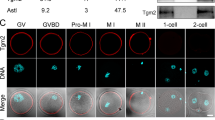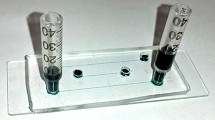Abstract
AQUEOUS extracts of mammalian testis contain a 'spreading' factor which dramatically increases the permeability of the skin to injected fluids. This factor is associated with the germinal epithelium and can be extracted from spermatozoa1. Factors with similar diffusing properties have been obtained from the most diverse sources, for example, from culture-filtrates and extracts of many species of invasive bacteria2, from snake and spider venoms3 and from leeches4. Chain and Duthie5 reported a remarkable mucolytic activity of these extracts characterized by a rapid fall in the viscosity of synovial fluid and the liberation of reducing substances. This observation has been confirmed and extended by other workers and it appears that these spreading factors are closely associated if not identical with a group of enzymes that hydrolyse the hyaluronic acid of the synovial fluid, vitreous humour, umbilical cord and skin6, and which are therefore known as hyaluronidases.
This is a preview of subscription content, access via your institution
Access options
Subscribe to this journal
Receive 51 print issues and online access
$199.00 per year
only $3.90 per issue
Buy this article
- Purchase on Springer Link
- Instant access to full article PDF
Prices may be subject to local taxes which are calculated during checkout
Similar content being viewed by others
References
Hoffmann, D. C., and Duran-Reynals, F., J. Exp. Med., 53, 387 (1931); McClean, D., J. Path. and Bact., 33, 1045 (1930); 34, 459 (1931).
Duran-Reynals, F., J. Exp. Med., 58, 161 (1933); McClean, D., J. Path. and Bact., 42, 477 (1936); 53, 13 (1941); 53, 156 (1941).
Duran-Reynals, F., J. Exp. Med., 69, 69 (1939).
Claude, A., J. Exp. Med., 66, 353 (1937).
Chain, E., and Duthie, E. S., Brit. J. Exp. Path., 21, 324 (1940).
Hobby, G. L., Dawson, M. H., Meyer, K., and Chaffee, E., J. Exp. Med., 73, 109 (1941); Madinaveitia, J., and Quibell, T. H. H., Biochem. J., 35, 453 (1941); McClean, D., and Hale, C. W., Biochem. J., 35, 159 (1941); Meyer, K., Chaffee, E., Hobby, G. L., and Dawson, M. H., J. Exp. Med., 73, 309 (1941).
McClean, D., Biol. Rev., 8, 345 (1933).
Long, J. A., Univ. Cal. Pub. Zool., 9, 105 (1912).
Pincus, G., and Enzmann, E. V., J. Exp. Med., 62, 665 (1935).
Yamane, J., Cytologia, 1, 394 (1930).
Pincus, G., and Enzmann, E. V., J. Exp. Zool., 73, 195 (1936).
Rowlands, I. W., NATURE, 150, 267 (1942).
Baker, J. R., Quart. J. Exp. Physiol., 21, 139 (1931).
Author information
Authors and Affiliations
Rights and permissions
About this article
Cite this article
MCCLEAN, D., ROWLANDS, I. ROLE OF HYALURONIDASE IN FERTILIZATION. Nature 150, 627–628 (1942). https://doi.org/10.1038/150627a0
Issue Date:
DOI: https://doi.org/10.1038/150627a0
This article is cited by
-
Hyaluronidase removal of the cumulus oophorus increases in vitro fertilization
Journal of In Vitro Fertilization and Embryo Transfer (1988)
-
Enzymatic Action of Lipoglycoprotein Preparations from Sperm-acrosomes on Rabbit Ova
Nature (1965)
Comments
By submitting a comment you agree to abide by our Terms and Community Guidelines. If you find something abusive or that does not comply with our terms or guidelines please flag it as inappropriate.



